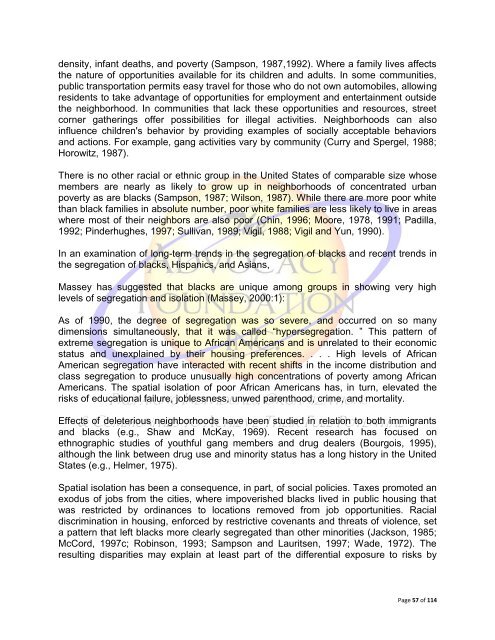African-American Youth in The Juvenile Justice System
African-American Youth in The Juvenile Justice System
African-American Youth in The Juvenile Justice System
Create successful ePaper yourself
Turn your PDF publications into a flip-book with our unique Google optimized e-Paper software.
density, <strong>in</strong>fant deaths, and poverty (Sampson, 1987,1992). Where a family lives affects<br />
the nature of opportunities available for its children and adults. In some communities,<br />
public transportation permits easy travel for those who do not own automobiles, allow<strong>in</strong>g<br />
residents to take advantage of opportunities for employment and enterta<strong>in</strong>ment outside<br />
the neighborhood. In communities that lack these opportunities and resources, street<br />
corner gather<strong>in</strong>gs offer possibilities for illegal activities. Neighborhoods can also<br />
<strong>in</strong>fluence children's behavior by provid<strong>in</strong>g examples of socially acceptable behaviors<br />
and actions. For example, gang activities vary by community (Curry and Spergel, 1988;<br />
Horowitz, 1987).<br />
<strong>The</strong>re is no other racial or ethnic group <strong>in</strong> the United States of comparable size whose<br />
members are nearly as likely to grow up <strong>in</strong> neighborhoods of concentrated urban<br />
poverty as are blacks (Sampson, 1987; Wilson, 1987). While there are more poor white<br />
than black families <strong>in</strong> absolute number, poor white families are less likely to live <strong>in</strong> areas<br />
where most of their neighbors are also poor (Ch<strong>in</strong>, 1996; Moore, 1978, 1991; Padilla,<br />
1992; P<strong>in</strong>derhughes, 1997; Sullivan, 1989; Vigil, 1988; Vigil and Yun, 1990).<br />
In an exam<strong>in</strong>ation of long-term trends <strong>in</strong> the segregation of blacks and recent trends <strong>in</strong><br />
the segregation of blacks, Hispanics, and Asians,<br />
Massey has suggested that blacks are unique among groups <strong>in</strong> show<strong>in</strong>g very high<br />
levels of segregation and isolation (Massey, 2000:1):<br />
As of 1990, the degree of segregation was so severe, and occurred on so many<br />
dimensions simultaneously, that it was called “hypersegregation. ” This pattern of<br />
extreme segregation is unique to <strong>African</strong> <strong>American</strong>s and is unrelated to their economic<br />
status and unexpla<strong>in</strong>ed by their hous<strong>in</strong>g preferences. . . . High levels of <strong>African</strong><br />
<strong>American</strong> segregation have <strong>in</strong>teracted with recent shifts <strong>in</strong> the <strong>in</strong>come distribution and<br />
class segregation to produce unusually high concentrations of poverty among <strong>African</strong><br />
<strong>American</strong>s. <strong>The</strong> spatial isolation of poor <strong>African</strong> <strong>American</strong>s has, <strong>in</strong> turn, elevated the<br />
risks of educational failure, joblessness, unwed parenthood, crime, and mortality.<br />
Effects of deleterious neighborhoods have been studied <strong>in</strong> relation to both immigrants<br />
and blacks (e.g., Shaw and McKay, 1969). Recent research has focused on<br />
ethnographic studies of youthful gang members and drug dealers (Bourgois, 1995),<br />
although the l<strong>in</strong>k between drug use and m<strong>in</strong>ority status has a long history <strong>in</strong> the United<br />
States (e.g., Helmer, 1975).<br />
Spatial isolation has been a consequence, <strong>in</strong> part, of social policies. Taxes promoted an<br />
exodus of jobs from the cities, where impoverished blacks lived <strong>in</strong> public hous<strong>in</strong>g that<br />
was restricted by ord<strong>in</strong>ances to locations removed from job opportunities. Racial<br />
discrim<strong>in</strong>ation <strong>in</strong> hous<strong>in</strong>g, enforced by restrictive covenants and threats of violence, set<br />
a pattern that left blacks more clearly segregated than other m<strong>in</strong>orities (Jackson, 1985;<br />
McCord, 1997c; Rob<strong>in</strong>son, 1993; Sampson and Lauritsen, 1997; Wade, 1972). <strong>The</strong><br />
result<strong>in</strong>g disparities may expla<strong>in</strong> at least part of the differential exposure to risks by<br />
Page 57 of 114

















